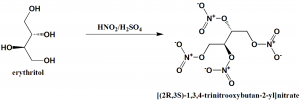ERYTHRITOL TETRANITRATE Synthesis, SAR, MCQ,Structure,Chemical Properties and Therapeutic Uses
Erythritol tetranitrate
IUPAC nomenclature
[(2R,3S)-1,3,4-trinitrooxybutan-2-yl]nitrateClassification
- Organic nitrate antianginal drug
Physiochemical Properties
| S. NO. | PHYSICAL AND CHEMICAL PROPERTIES | |
| 1 | Molecular weight | 302.11 g/mol |
| 2 | Physical appearance | Solid |
| 3 | Melting point | 61oC |
| 4 | Solubility | 1.95e-01 gm/L |
| 5 | Octanol/water partition coefficient | N/A |
| 5 | Presence of ring | Not present |
| 6 | Number of chiral centers | 2 |
Mechanism of Action
i. Conversion of the drug into active intermediate compound.
ii. Intermediate activates guanylate cyclase enzyme.
iii. This activates the synthesis of cyclic guanosin 3’,5’-monophosphate (cGMP).
iv. Due to this, there is an activation of the cascade of protein kinase-dependent phosphorylation events in the smooth muscles.
v. Relaxation is caused in the smooth muscles due to dephosphorylation of the myosin light chain of smooth muscles, due to which, there is increased in blood flow in veins, arteries and cardiac tissues.
vi. Heart has to do lesser work and blood pressure and angina tension also reduces. There is increased blood flow in the myocardium.
Structure Activity Relationship
General structure activity of organic nitrate antianginal drugs can be summarized as:
- The number of nitrate groups determines the potency of organic nitrate for guanylate cyclase activation.
- Increase in nitric group increases the potency.
- Increase in lipophillicity doesn’t have major effect over activation of drug.
Method of synthesis
Nitration of erythritol using concentrated sulfuric acid and nitrate salt. [2]
Medicinal Uses
Erythritol tetranitrate is used for treatment and prevention of:
- Angina
Side Effects
Side effects of Erythritol tetranitrate are:
- Low blood vessels
- Disturbed heart beats
- Dizziness
- Facial flushing
- Methmoglobinemia
- Headache
- Weakness
- Apprehension
- Allergic reactions
MCQs
Q.1 Which of the following statements are correct related with the physicochemical properties of drug erythritol tetranitrate?
I. Molecular weight: 302.11 gm/mol
II. Physical appearance: solid
III. Melting point: 61 oC
a) I, II, III
b) I, II
c) II, III
d) I, III
Q.2 Match the following of the drugs with their correct IUPAC names.
| i. Erythritol tetranitrate | A. (2R)-2-{2-[(1R)-1-(4-chlorophenyl)-1-phenylethoxy]ethyl}-1-methylpyrrolidine |
| ii. Cyclizine | B. 1-benzhydryl-4-methyl-piperazine |
| iii. Clemastine | C. 4-hydroxy-2-methyl-N-(5-methyl-1,2-oxazol-3-yl)-1,1-dioxo-1λ6,2-benzothiazine-3-carboxamide |
| iv. Isoxicam | D. [(2R,3S)-1,3,4-trinitrooxybutan-2-yl]nitrate |
a) i-B, ii-C, iii-D, iv-A
b) i-D, ii-C, iii-B, iv-A
c) i-D, ii-B, iii-A, iv-C
d) i-B, ii-A, iii-D, iv-C
Q.3 Mechanism of action of drug erythritol tetranitrate includes?
I. Conversion into active intermediate compound
II. Activation of gunaylate cyclase enzyme
III. Active synthesis of cGMP
IV. Relaxation of smooth muscles.
a) I, III, IV
b) I, III
c) II, III
d) I, II, III, IV
Q.4 Correct sequence for True/false for the classification of the drug can be?
- Erythritol tetranitrate: Organic nitrate antianginal drug
- Alprazolam: Sedative hypnotics
- Phenytoin: Anticonvuslants
- Desflurane: Inhalational anesthetics
a) TFFT
b) FFTT
c) FFTF
d) TTTT
Q.5 Number of nitrate groups in organic nitrate antianginal drugs-
a) Determines the potency of drug
b) Have no influence on activity of drug
c) Is not necessary for the action of drug
d) Makes the drug inactive
Q.6 The correct sequence for the steps for synthesis of drug erythritol tetranitrate from erythritol can be?
I. Nitration
II. Solfonation
III. Oxidation
IV.Reduction
a) II – I – III
b) I
c) III – I
d) IV – I – II
Q.7 Side effect of drug erythritol tetranitrate is/are?
a) Dizziness
b) Headache
c) Allergic reactions
d) All of the above
Participate in Online FREE GPAT TEST: CLICK HERE
Participate in Online FREE Pharmacist TEST: CLICK HERE
Participate in Online FREE Drug Inspector TEST: CLICK HERE
Participate in CSIR NET JRF Mock Test
ANSWERS
1-a
2-c
3-d
4-d
5-a
6-b
7-d
REFERENCES
[1] Vardanyan R, Hruby V. Synthesis of essential drugs. Elsevier; 2006 Mar 10.

